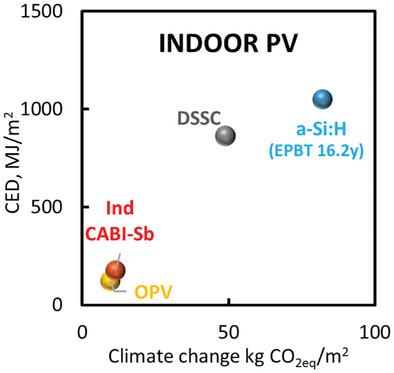当前位置:
X-MOL 学术
›
Adv. Energy Mater.
›
论文详情
Our official English website, www.x-mol.net, welcomes your
feedback! (Note: you will need to create a separate account there.)
Assessing the Environmental Impact of Pnictogen‐based Perovskite‐Inspired Materials for Indoor Photovoltaics
Advanced Energy Materials ( IF 24.4 ) Pub Date : 2024-11-18 , DOI: 10.1002/aenm.202403981 Rosario Vidal, Noora Lamminen, Ville Holappa, Jaume‐Adrià Alberola‐Borràs, Iván P. Franco, G. Krishnamurthy Grandhi, Paola Vivo
Advanced Energy Materials ( IF 24.4 ) Pub Date : 2024-11-18 , DOI: 10.1002/aenm.202403981 Rosario Vidal, Noora Lamminen, Ville Holappa, Jaume‐Adrià Alberola‐Borràs, Iván P. Franco, G. Krishnamurthy Grandhi, Paola Vivo

|
The development of eco‐friendly indoor photovoltaics (IPVs) for Internet‐of‐Things (IoT) devices is booming. Emerging IPVs, especially those based on lead halide perovskites (LHPs), outperform the industry standard of amorphous hydrogenated silicon (a‐Si:H). However, the toxic lead in LHPs drives the search for safer alternatives. Perovskite‐inspired materials (PIMs) containing bismuth (Bi) and antimony (Sb) have shown promise, achieving indoor power conversion efficiencies (PCE) approaching 10% despite early research stages. This is promising due to their eco‐friendlier light‐harvesting layers compared to LHPs. Yet, the environmental footprint of pnictogen‐based PIM over their lifecycle remains unassessed. This study conducts a life‐cycle assessment (LCA) of the best‐performing Sb‐ and Bi‐PIMs, considering PCE, raw material availability, energy consumption, and waste generation. It is find that PCE plays a decisive role in identifying the PIM for IPVs with minimized environmental impact, namely a Bi‐Sb alloy. Extended LCA simulations for industrial‐scale processing show that the most promising Bi‐PIM has a reduced environmental burden compared to a‐Si:H. It is also explore challenges and solutions for enhancing Bi‐and Sb‐PIMs’ sustainability. Overall, this study provides the first evidence of the potential of pnictogen‐based PIMs as a sustainable IPV technology, addressing whether lead‐free PIMs are truly eco‐friendly, thus contributing toward battery‐less IoT applications.
中文翻译:

评估基于 Pnictogen 的钙钛矿启发材料对室内光伏的环境影响
用于物联网 (IoT) 设备的环保室内光伏 (IPV) 的开发正在蓬勃发展。新兴的 IPVs,尤其是基于氢化铅钙钛矿 (LHP) 的 IPVs,其性能优于非晶氢化硅 (a-Si:H) 的行业标准。然而,LHP 中的有毒铅推动了对更安全替代品的寻找。含有铋 (Bi) 和锑 (Sb) 的钙钛矿启发材料 (PIM) 已显示出前景,尽管处于早期研究阶段,但室内功率转换效率 (PCE) 仍接近 10%。这是有希望的,因为与 LHP 相比,它们的光收集层更环保。然而,基于 pnictogen 的 PIM 在其生命周期中的环境足迹仍未得到评估。本研究对表现最佳的 Sb 和 Bi-PIM 进行了生命周期评估 (LCA),考虑了 PCE、原材料可用性、能源消耗和废物产生。研究发现,PCE 在识别对环境影响最小的 IPVs PIM 方面起着决定性的作用,即 Bi-Sb 合金。用于工业规模加工的扩展 LCA 模拟表明,与 a-Si:H 相比,最有前途的 Bi-PIM 减轻了环境负担。它还探讨了提高 Bi 和 Sb PIM 可持续性的挑战和解决方案。总体而言,这项研究提供了第一个证据,证明基于 pnictogen 的 PIM 作为一种可持续的 IPV 技术的潜力,解决了无铅 PIM 是否真正环保的问题,从而有助于无电池物联网应用。
更新日期:2024-11-18
中文翻译:

评估基于 Pnictogen 的钙钛矿启发材料对室内光伏的环境影响
用于物联网 (IoT) 设备的环保室内光伏 (IPV) 的开发正在蓬勃发展。新兴的 IPVs,尤其是基于氢化铅钙钛矿 (LHP) 的 IPVs,其性能优于非晶氢化硅 (a-Si:H) 的行业标准。然而,LHP 中的有毒铅推动了对更安全替代品的寻找。含有铋 (Bi) 和锑 (Sb) 的钙钛矿启发材料 (PIM) 已显示出前景,尽管处于早期研究阶段,但室内功率转换效率 (PCE) 仍接近 10%。这是有希望的,因为与 LHP 相比,它们的光收集层更环保。然而,基于 pnictogen 的 PIM 在其生命周期中的环境足迹仍未得到评估。本研究对表现最佳的 Sb 和 Bi-PIM 进行了生命周期评估 (LCA),考虑了 PCE、原材料可用性、能源消耗和废物产生。研究发现,PCE 在识别对环境影响最小的 IPVs PIM 方面起着决定性的作用,即 Bi-Sb 合金。用于工业规模加工的扩展 LCA 模拟表明,与 a-Si:H 相比,最有前途的 Bi-PIM 减轻了环境负担。它还探讨了提高 Bi 和 Sb PIM 可持续性的挑战和解决方案。总体而言,这项研究提供了第一个证据,证明基于 pnictogen 的 PIM 作为一种可持续的 IPV 技术的潜力,解决了无铅 PIM 是否真正环保的问题,从而有助于无电池物联网应用。


















































 京公网安备 11010802027423号
京公网安备 11010802027423号